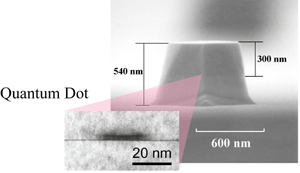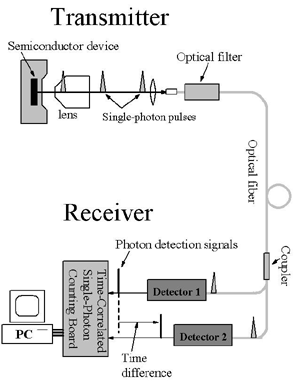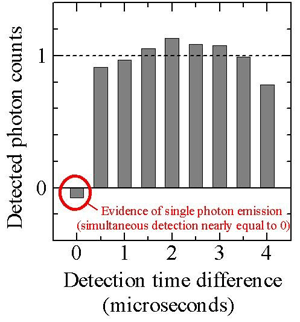Tokyo, July 15, 2004
The University of Tokyo's Nanoelectronics Collaborative Research Center and Fujitsu Laboratories Ltd. today announced the joint development of technologies that generate and measure single-photons(1), succeeding in observing the world's first emission of single-photons in data transmission wavelengths. The newly developed technologies pave the way for accelerating speeds for quantum encryption data transmission(2), considered the ultimate method of encrypted transmission, to 400 times faster than the data transmission speeds of conventional quantum encryption that could only transfer data at a few hundred bits per second (bps). The technologies represent a major step forward towards the practical application of quantum encryption data transmission.
Details of the new technologies will be presented at The 27th International Conference on the Physics of Semiconductors (ICPS-27) to be held in Arizona, U.S. from July 26.
Partial research and development of the new technologies were supported by the Nano-Photonic and Electron Devices Technology Project, one of several projects of an IT program of Japan's Ministry of Education, Culture, Sports, Science and Technology (MEXT), entitled "Focused Research and Development Project for the Realization of the World's Most Advanced IT Nation." The National Institute for Materials Science (NIMS) of Japan also cooperated on the new developments.
Background
There is growing demand for higher-level security for data transmission with the ever-increasing use of electronic commerce over the Internet. In particular, transmission using quantum encryption, which is considered to be impossible to eavesdrop on and the ultimately secure method of encrypted transmission, is being actively studied and developed worldwide.
Technological Challenges
To enable data transmission using quantum encryption, a single-photon generator capable of limiting emission of photons to one photon per pulse is required. However, technology to generate single-photons did not exist for wavelengths used in practical optical fiber transmission (1.3 - 1.55 micron), therefore laser was used in place of single-photons for conventional quantum encryption experiments.
When using laser for transmission involving quantum encryption, there is the risk of having two or more photons per single pulse, leaving the potential for eavesdropping. In order to lower the risk of emitting two or more photons, it is necessary to dramatically reduce light intensity. As such, laser-sourced quantum encryption for long-range transmission could only achieve extremely slow transmission speeds of a few hundred bps.
Newly Developed Technologies
The new technologies realize the emission and measurement of single-photons in practical transmission wavelengths of 1.3 to 1.55 microns.
Features of the new technologies are as follows:
1. Technology to Emit Single-Photons in Data Transmission Wavelengths (Figure 1)
Utilizing optical simulation, a semiconductor device capable of emitting single-photons efficiently from nanometer-sized structures called quantum dots was designed. A semiconductor process technology that does not impair the minutely structured quantum dots was also newly developed. These developments enable single-photon emission in data transmission wavelengths, which had been unachievable in the past. The quantum dots that were used for this technology were jointly created by Dr. Yoshiki Sakuma's research group at the National Institute for Materials Science of Japan, and Fujitsu Laboratories Ltd.
2. Technology to Measure Single-Photons in Data Transmission Wavelengths (Figure 2)
A single-photon transmitter was designed and developed to efficiently collect light emitted from the newly developed semiconductor chip and transmit only light that is emitted from quantum dots to optical fibers. A single-photon receiver was also designed and developed, capable of splitting light which has passed through an optical fiber into two and accurately measuring the detection time of the split light. By confirming that detection times of the split light are not simultaneous, it is now possible to prove that the emitted light is a single-photon.
Results
Experiments that were run on the newly developed technologies confirmed that both parts of the light split into two were not detected simultaneously after noise correction, thereby verifying that single-photons were successfully emitted from quantum dots in data transmission wavelengths. (Figure 3)
Although verification of single-photons for the new developments was for wavelengths of 1.3 microns, light emissions from quantum dots for the more commonly used 1.55 micron wavelengths were also successfully observed.
With the confirmation of single-photon transmission over conventional data transmission wavelengths, quantum encryption transmission is now possible without lowering the sender's light emission intensity. This breakthrough enables transmission at speeds of 100kbps (kilobits per second) across a distance of approximately 100 kilometers, 400 times faster than conventional laser-sourced quantum encryption transmission. This dramatically increases the potential for the practical application of quantum encryption transmission technology for use at sites such as governmental, financial, and medical sites that require high-level data security.
Future Developments
The University of Tokyo and Fujitsu Laboratories Ltd. will promote further R&D to verify single-photon transmissions in 1.55 micron wavelengths and aim to increase single-photon extraction efficiency, targeting realization of a practical single-photon generator by approximately 2007. The development of quantum computation technology and quantum relay technology will also be promoted for the realization of quantum networks.
 Figure 1. Newly developed semiconductor device that emits single-photons
Figure 1. Newly developed semiconductor device that emits single-photons
 Figure 2. Single-photon measurement technology
Figure 2. Single-photon measurement technology
 Figure 3. Single-photon measurement test results
Figure 3. Single-photon measurement test results
![]() Phone: +81-46-250-8234
Phone: +81-46-250-8234![]() E-mail: nano-qc@labs.fujitsu.com
E-mail: nano-qc@labs.fujitsu.com![]() Phone: +81-3-5452-6245
Phone: +81-3-5452-6245

